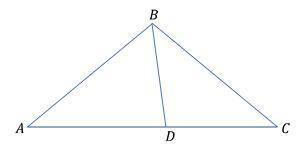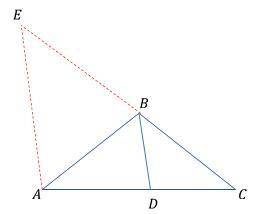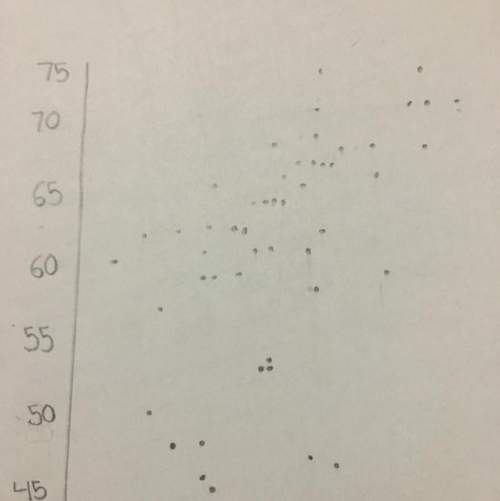Refer to the triangle for numbers 8 – 19.
(First triangle is here)
The angl...

Mathematics, 21.02.2020 18:01 littlebirdd987
Refer to the triangle for numbers 8 – 19.
(First triangle is here)
The angle bisector theorem state that the ratio of AB/AD is equal to the ratio of BC/CD. Is the ratio of (AB+BC)/(AD+DC) the same?
First, extend line BC. Then draw a line from point A, parallel to segment BD and intersecting the extended BC. The point of intersection will be E. The image will appear like the one below.
8. Classify angle AEC and angle DBCas corresponding, alternate interior, alternate exterior, or same side interior angles.
(Second triangle here)
9. When lines are parallel, are angles AEC and DBC congruent or supplementary?
10. In ∆AEC and ∆DBC angle C is shared. What property confirms that angle C will be congruent in both triangles?
11. Which similarity postulate or theorem confirms that ∆AEC~∆DBC
12. Complete the proportion BC/?=?/AC
13. Use the segment addition postulate to rewrite the length of EC.
14. Use the substitution property and plug the answer to number 13 into the proportion in number 12
15. Classify angle BAE and angle DBA as corresponding, alternate interior, alternate exterior, or same side interior angles.
16. When lines are parallel, are angles BAE and DBA congruent or supplementary?
17. Since it was given that angles DBA and DBC were congruent, which property can be used to say angles BAE and AEC are also congruent?
18. Classify ∆ABE as isosceles, scalene, or equilateral.
19. Use the substitution property and the proportion in number 14 to confirm the ratios at the start are the same.



Answers: 2


Another question on Mathematics

Mathematics, 21.06.2019 21:40
The graph of f(x) = |x| is transformed to g(x) = |x + 11| - 7. on which interval is the function decreasing?
Answers: 3

Mathematics, 22.06.2019 00:00
I've been working on this for a few days and i just don't understand, it's due in a few hours. you.the direction of a vector is defined as the angle of the vector in relation to a horizontal line. as a standard, this angle is measured counterclockwise from the positive x-axis. the direction or angle of v in the diagram is α.part a: how can you use trigonometric ratios to calculate the direction α of a general vector v = < x, y> similar to the diagram? part bsuppose that vector v lies in quadrant ii, quadrant iii, or quadrant iv. how can you use trigonometric ratios to calculate the direction (i.e., angle) of the vector in each of these quadrants with respect to the positive x-axis? the angle between the vector and the positive x-axis will be greater than 90 degrees in each case.part cnow try a numerical problem. what is the direction of the vector w = < -1, 6 > ?
Answers: 1

Mathematics, 22.06.2019 01:30
Which of the following points is a solution to the system of equations shown? y - x = -1 x + y = -5
Answers: 2

Mathematics, 22.06.2019 04:00
If f(x)=1/x and g(x)=x+4 which of the following is the graph
Answers: 2
You know the right answer?
Questions


Mathematics, 29.01.2020 03:51







Mathematics, 29.01.2020 03:51

Mathematics, 29.01.2020 03:51

Health, 29.01.2020 03:51

English, 29.01.2020 03:51

Chemistry, 29.01.2020 03:51

Mathematics, 29.01.2020 03:51

Mathematics, 29.01.2020 03:51


Mathematics, 29.01.2020 03:51


History, 29.01.2020 03:51

Mathematics, 29.01.2020 03:51




